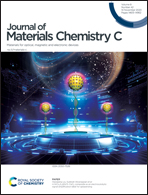Tuning the mechanical and electronic properties and carrier mobility of phosphorene via family atom doping: a first-principles study†
Abstract
Doping has been demonstrated to be an effective method to improve the properties of two-dimensional materials. In this work, the mechanical and electrical properties, and carrier mobility of substitutionally doped phosphorene with group VA elements have been systematically researched using first-principles density functional theory calculations. All doping systems maintain non-magnetic semiconductor characteristics. Due to the large bond lengths and formation energy, the N-doped phosphorene is the most unstable system in terms of structure and energy. The Sb- and Bi-doped phosphorenes exhibit higher Poisson's ratio anisotropy, and a near-zero Poisson's ratio is found at specific angles. N doping increases phosphorene's bandgap value, whereas As, Sb, and Bi doping decreases it. Furthermore, the N dopant induces a direct–indirect bandgap transition in the phosphorene. This transition is caused by a shift of the valence band maximum. More interestingly, the calculated carrier mobility indicates that the N element doping may be an alternative way to simultaneously improve the electron mobility and hole mobility for phosphorene. Overall, these results provide useful guidance for selecting suitable dopants to enhance the properties of phosphorene.



 Please wait while we load your content...
Please wait while we load your content...